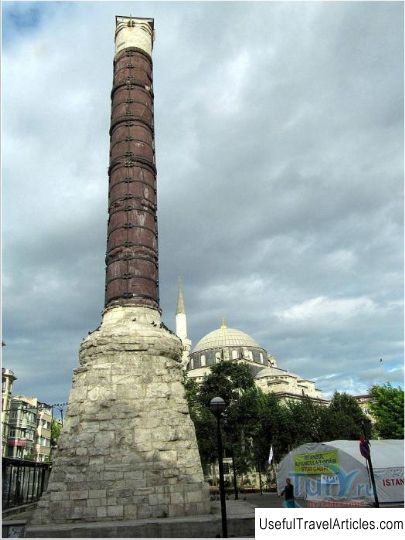Column of Constantine (Cemberlitas) description and photos - Turkey: Istanbul
Rating: 8,8/10 (7543 votes) 
Column of Constantine (Cemberlitas) description and photos - Turkey: Istanbul. Detailed information about the attraction. Description, photographs and a map showing the nearest significant objects. The title in English is Cemberlitas. Photo and descriptionChamberlitas is a square located on the site where the ancient Forum of Emperor Constantine was located. Of all the structures of this complex, only the column of Constantine has partially survived. This column has long been considered the main symbol of the Byzantine Empire. It was erected by decree of the Emperor Constantine on May 11, 330 in honor of the conquest of Byzantium on September 18, 324. It happened on November 8, 324 during the celebrations and on the occasion of the proclamation of the new capital of the Roman Empire - Constantinople. From the very beginning, it was a pedestal for the statue of the emperor. This column was the centerpiece of the grand square, where the colonnade and statues of Christian saints and pagan gods were also placed. It is currently called Chamberlitash (which translates as “Rock with hoops”). The only drawing of this column that has survived and has survived to our times dates back to 1574 and is kept in the library of the College of the Holy Trinity in the English city of Cambridge. You can get to the structure if you walk from Sultanahmet Square towards the Great Istanbul Bazaar and Beyazet Square along Divan Yolu Street. It was erected in the center of the Constantine Forum, which at the same time was built on the second city hill, just behind the defensive walls of old Byzantium. Then this forum was an oval-shaped square, surrounded by an imposing marble colonnade, which had two monumental gates that faced the west and east of the city. It was decorated with many beautiful antique statues, the location of which is now impossible to determine. The column is made in the form of a truncated regular four-step pyramid and erected on a five-meter base made of porphyry. On it was a column chair, which had a square shape and was decorated with a bas-relief. The barrel, which was twenty-five meters high, consisted of seven drums, the diameter of which was about three meters. The drums were wrapped in metal hoops with gilded bronze wreaths closed. All drums were also porphyry, except for the eighth - it was made of marble. The majestic structure is crowned with a marble capital. A golden imperial statue in the shape of the god Apollo was erected on the abacus of the capital, with a nail from the Cross of the Son of God fused into it. For this reason, the inhabitants of the city of Constantinople initially began to call this architectural monument "the Column of the Nail". The height of the monument was about 38 meters. During the earthquake of 600 - 601, which occurred at the end of the reign of the Emperor Mauritius, the statue of Constantine the Great collapsed, while the column itself was severely damaged. It was completely restored during the reign of Emperor Heraclius (610 - 641), and in 1081 - 1118, under Emperor Alexei I, the statue again fell to the ground from being hit by lightning and crushed several passers-by. The monument was restored only during the reign of Emperor Manuel I (1143 - 1180), but soon the statue collapsed again and it was replaced with a cross. After this event, the monument received a new colloquial name - "Column with the Cross". Later, after 1204, this building was badly damaged by the actions of the crusaders. Its foundation was weakened by an adit, which was dug in order to search for relics, and the bas-relief was removed and taken to Western Europe. At the present time, part of it, which the Turks call "Tetrarchs", was embedded in the wall of St. Mark's Cathedral in Venice. Already in the second half of the 20th century, during archaeological excavations carried out in Constantinople, the missing element was found bas-relief, which is currently kept in the archaeological museum of Istanbul. After the fall of Constantinople, which occurred in early June 1453, the Turks threw the cross from this column. In 1779, a strong fire that occurred in the vicinity of the square destroyed most of the buildings, and the column left black spots from fire. The column received the nickname "The Burnt Column" after this event. By order of Sultan Abdulhamid I, Chamberlitash was restored and new foundations were laid on it. The iron hoops were replaced with new ones. This made it possible to keep the column in an upright position in subsequent centuries. The first base of the column was located about 3 meters below the current level. This means that the column, which is presented today for viewing by tourists, is, in fact, only a part of the original structure. Haluk Egemen Sarikaya, a Turkish parapsychologist, wrote the following about this column in one of his works: "Like any sacred structure, Chamberlitash is probably connected with the underground system of the area." Confirmation of these words was found in the 1930s during archaeological excavations in the vicinity of the Column of Constantine, during which lobbies made in the shape of a labyrinth were discovered. Hence the conviction that Chamberlitas is a kind of gateway providing access to the underground galleries of Istanbul.          We also recommend reading Naypyidaw Water Fountain Garden description and photos - Myanmar: Naypyidaw Topic: Column of Constantine (Cemberlitas) description and photos - Turkey: Istanbul. |




